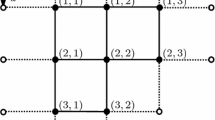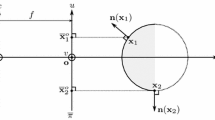Abstract
This paper studies the discontinuity preservation problem in recovering a surface from its surface normal map. To model discontinuities, we introduce the assumption that the surface to be recovered is semi-smooth, i.e., the surface is one-sided differentiable (hence one-sided continuous) everywhere in the horizontal and vertical directions. Under the semi-smooth surface assumption, we propose a bilaterally weighted functional for discontinuity preserving normal integration. The key idea is to relatively weight the one-sided differentiability at each point’s two sides based on the definition of one-sided depth discontinuity. As a result, our method effectively preserves discontinuities and alleviates the under- or over-segmentation artifacts in the recovered surfaces compared to existing methods. Further, we unify the normal integration problem in the orthographic and perspective cases in a new way and show effective discontinuity preservation results in both cases (Source code is available at https://github.com/hoshino042/bilateral_normal_integration.).
Access this chapter
Tax calculation will be finalised at checkout
Purchases are for personal use only
Similar content being viewed by others
Notes
- 1.
- 2.
See experiments in the supplementary material.
- 3.
The method we call robust estimator is called non-convex estimator in [25].
- 4.
References
Agrawal, A., Raskar, R., Chellappa, R.: What is the range of surface reconstructions from a gradient field? In: Leonardis, A., Bischof, H., Pinz, A. (eds.) ECCV 2006. LNCS, vol. 3951, pp. 578–591. Springer, Heidelberg (2006). https://doi.org/10.1007/11744023_45
Badri, H., Yahia, H., Aboutajdine, D.: Robust surface reconstruction via triple sparsity. In: Proceedings of Computer Vision and Pattern Recognition (CVPR), pp. 2283–2290 (2014)
Cao, X., Shi, B., Okura, F., Matsushita, Y.: Normal integration via inverse plane fitting with minimum point-to-plane distance. In: Proceedings of Computer Vision and Pattern Recognition (CVPR), pp. 2382–2391 (2021)
Chabert, C.F., et al.: Relighting human locomotion with flowed reflectance fields. In: Proceedings of ACM SIGGRAPH (2006)
Deschaintre, V., Lin, Y., Ghosh, A.: Deep polarization imaging for 3D shape and SVBRDF acquisition. In: CVPR, pp. 15567–15576 (2021)
Durou, J.D., Aujol, J.F., Courteille, F.: Integrating the normal field of a surface in the presence of discontinuities. In: Workshops of the Computer Vision and Pattern Recognition (CVPRW) (2009)
Durou, J.D., Courteille, F.: Integration of a normal field without boundary condition. In: Workshops of the International Conference on Computer Vision (ICCVW) (2007)
Harker, M., O’Leary, P.: Least squares surface reconstruction from measured gradient fields. In: Proceedings of Computer Vision and Pattern Recognition (CVPR) (2008)
Harker, M., O’Leary, P.: Least squares surface reconstruction from gradients: direct algebraic methods with spectral, Tikhonov, and constrained regularization. In: Proceedings of Computer Vision and Pattern Recognition (CVPR) (2011)
Harker, M., O’leary, P.: Regularized reconstruction of a surface from its measured gradient field. J. Math. Imaging Vision 51, 46–70 (2015)
Hestenes, M.R., Stiefel, E.: Methods of conjugate gradients for solving linear systems. J. Res. Natl. Bureau Stand. 49(6), 409 (1952)
Holland, P.W., Welsch, R.E.: Robust regression using iteratively reweighted least-squares. Commun. Stat.-theory Methods 6(9), 813–827 (1977)
Horn, B.K., Brooks, M.J.: The variational approach to shape from shading. In: Computer Vision, Graphics, and Image Processing(1986)
Horovitz, I., Kiryati, N.: Depth from gradient fields and control points: bias correction in photometric stereo. Image Vision Comput. 22, 681–694 (2004)
Ikehata, S.: CNN-PS: CNN-based photometric stereo for general non-convex surfaces. In: Proceedings of European Conference on Computer Vision (ECCV), pp. 3–18 (2018)
Ikeuchi, K.: Constructing a depth map from images. Technical report, Massachusetts Inst of Tech Cambridge Artificial Intelligence Lab (1983)
Kadambi, A., Taamazyan, V., Shi, B., Raskar, R.: Polarized 3D: high-quality depth sensing with polarization cues. In: Proceedings of International Conference on Computer Vision (ICCV) (2015)
Karacali, B., Snyder, W.: Reconstructing discontinuous surfaces from a given gradient field using partial integrability. Comput. Vision Image Underst. 92, 78–111 (2003)
Klette, R., Schluens, K.: Height data from gradient maps. In: Machine Vision Applications, Architectures, and Systems Integration V, vol. 2908, pp. 204–215. SPIE (1996)
Li, M., Zhou, Z., Wu, Z., Shi, B., Diao, C., Tan, P.: Multi-view photometric stereo: a robust solution and benchmark dataset for spatially varying isotropic materials. IEEE Trans. Image Process. 29, 4159–4173 (2020)
Ng, H.S., Wu, T.P., Tang, C.K.: Surface-from-gradients without discrete integrability enforcement: a Gaussian kernel approach. IEEE Trans. Pattern Anal. Mach. Intell. (PAMI) 32(11), 2085–2099 (2009)
Nimier-David, M., Vicini, D., Zeltner, T., Jakob, W.: Mitsuba 2: a retargetable forward and inverse renderer. ACM Trans. Graph. (TOG) 38(6), 1–17 (2019)
Quéau, Y., Durou, J.-D.: Edge-preserving integration of a normal field: weighted least-squares, TV and \(L^1\) approaches. In: Aujol, J.-F., Nikolova, M., Papadakis, N. (eds.) SSVM 2015. LNCS, vol. 9087, pp. 576–588. Springer, Cham (2015). https://doi.org/10.1007/978-3-319-18461-6_46
Quéau, Y., Durou, J.D., Aujol, J.F.: Normal integration: a survey. J. Math. Imaging Vision 60, 576–593 (2018)
Quéau, Y., Durou, J.D., Aujol, J.F.: Variational methods for normal integration. J. Math. Imaging Vision 60, 609–632 (2018)
Saracchini, R.F., Stolfi, J., Leitão, H.C., Atkinson, G.A., Smith, M.L.: A robust multi-scale integration method to obtain the depth from gradient maps. Comput. Vision Image Underst. 116(8), 882–895 (2012)
Shi, B., Mo, Z., Wu, Z., Duan, D., Yeung, S.K., Tan, P.: A benchmark dataset and evaluation for non-Lambertian and uncalibrated photometric stereo. IEEE Trans. Pattern Anal. Mach. Intell. (PAMI) (2019)
Wang, Y., Bu, J., Li, N., Song, M., Tan, P.: Detecting discontinuities for surface reconstruction. In: Proceedings of International Conference on Pattern Recognition (ICPR), pp. 2108–2111. IEEE (2012)
Woodham, R.J.: Photometric stereo: a reflectance map technique for determining surface orientation from image intensity. In: Proceedings of Image Understanding Systems and Industrial Applications I (1979)
Wu, T.P., Tang, C.K.: Visible surface reconstruction from normals with discontinuity consideration. In: Proceedings of Computer Vision and Pattern Recognition (CVPR), vol. 2, pp. 1793–1800. IEEE (2006)
Xie, W., Wang, M., Wei, M., Jiang, J., Qin, J.: Surface reconstruction from normals: a robust DGP-based discontinuity preservation approach. In: Proceedings of Computer Vision and Pattern Recognition (CVPR) (2019)
Xiu, Y., Yang, J., Tzionas, D., Black, M.J.: ICON: implicit clothed humans obtained from normals. In: Proceedings of Computer Vision and Pattern Recognition (CVPR), pp. 13296–13306 (2022)
Zhu, D., Smith, W.A.P.: Least squares surface reconstruction on arbitrary domains. In: Vedaldi, A., Bischof, H., Brox, T., Frahm, J.-M. (eds.) ECCV 2020. LNCS, vol. 12367, pp. 530–545. Springer, Cham (2020). https://doi.org/10.1007/978-3-030-58542-6_32
Acknowledgments
This work was supported by JSPS KAKENHI Grant Number JP19H01123, and National Natural Science Foundation of China under Grant No. 62136001, 61872012.
Author information
Authors and Affiliations
Corresponding author
Editor information
Editors and Affiliations
1 Electronic supplementary material
Below is the link to the electronic supplementary material.
Rights and permissions
Copyright information
© 2022 The Author(s), under exclusive license to Springer Nature Switzerland AG
About this paper
Cite this paper
Cao, X., Santo, H., Shi, B., Okura, F., Matsushita, Y. (2022). Bilateral Normal Integration. In: Avidan, S., Brostow, G., Cissé, M., Farinella, G.M., Hassner, T. (eds) Computer Vision – ECCV 2022. ECCV 2022. Lecture Notes in Computer Science, vol 13661. Springer, Cham. https://doi.org/10.1007/978-3-031-19769-7_32
Download citation
DOI: https://doi.org/10.1007/978-3-031-19769-7_32
Published:
Publisher Name: Springer, Cham
Print ISBN: 978-3-031-19768-0
Online ISBN: 978-3-031-19769-7
eBook Packages: Computer ScienceComputer Science (R0)




